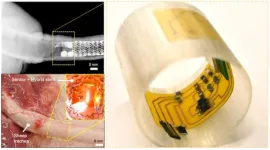(Press-News.org) ROCHESTER, Minn. — A study at Mayo Clinic suggests that an hourglass-shaped stent could improve blood flow and ease severe and reoccurring chest pain in people with microvascular disease. Of 30 participants in a phase 2 clinical trial, 76% saw improvement in their day-to-day life. For example, some participants who reported not being able to walk around the block or up a flight of stairs without chest pain were able to do these ordinary physical activities at the end of a 120-day period. Clinical measures of blood flow related to the microvasculature of the heart significantly improved during follow-up, according to findings published in the Journal of the American College of Cardiology: Cardiovascular Interventions.
Microvascular disease is a condition in which tiny blood vessels in the heart are not working properly, resulting in reduced blood flow to the heart. The resulting chest pains, or angina, can be debilitating, limiting a person's ability to exercise, do household chores or even walk to the mailbox. About 40% of patients receiving a diagnostic coronary angiogram for chest pain do not have blocked arteries that also can cause angina. However, up to 66% of these patients do have coronary microvascular disease, which is more common in women overall and found in people with conditions such as diabetes, high blood pressure and obesity.
For decades, there have been few viable treatment options to improve blood flow through the tiny vessels of the heart. At most, doctors have treated symptoms of angina with several medications and cardiovascular disease prevention methods, including healthy eating, weight loss and regular exercise. The use of a stent could target the issue behind the chest pain — the severe reduction in blood flow affecting the heart muscle.
Unlike tube-shaped stents used to open clogged arteries, the hourglass-shaped stent narrows in the middle. The different design is thought to increase back pressure, redistributing blood flow more fully through small vessels in the heart that were not working at capacity.
"The patients with heart-related microvascular dysfunction in this study had little ability to control their chronic angina, which severely limited their day-to-day activities," says Amir Lerman, M.D., a cardiologist at Mayo Clinic and senior author of the study. "Beyond reductions in chest pain and being able to comfortably handle more physical activity, the majority of patients in the study also showed a connection between the changes in their coronary flow reserve, which is a measure of maximum blood flow, and changes in their quality-of-life responses on the survey. This points to the link between the physiological measurement and angina symptoms."
Dr. Lerman notes that more studies are needed to better understand how the reducer stent works and its long-term effects on blood flow. The stent did not improve chest pain symptoms in 20%-30% of the participants, so future research studies will need to better identify which patients respond best to this therapy.
###
About Mayo Clinic
Mayo Clinic is a nonprofit organization committed to innovation in clinical practice, education and research, and providing compassion, expertise and answers to everyone who needs healing. Visit the Mayo Clinic News Network for additional Mayo Clinic news.
END
Hourglass-shaped stent could ease severe chest pain from microvascular disease
2024-11-07
ELSE PRESS RELEASES FROM THIS DATE:
United Nations ratifies framework to protect people on cash app
2024-11-07
As mobile-money services were growing at a rapid clip in the developing world 10 years ago, University of Florida computer scientists and cybersecurity experts Kevin Butler and Patrick Traynor were early sentinels, raising concerns about the lack of security that could lead to real problems for the user.
In a 2014 study, the two professors from UF’s Department of Computer and Information Science and Engineering, uncovered security vulnerabilities of mobile cash apps, especially in the Global South, where such technologies were becoming essential in the absence of robust banking systems.
“Our early work uncovered ...
Oklahoma State basketball team joins the Nation of Lifesavers
2024-11-07
http://newsroom.heart.org/news/oklahoma-state-basketball-team-joins-the-nation-of-lifesavers?preview=8409af5e5a5f3127f6aec7e122cc9673STILLWATER, Okla., October 28, 2024 — The Oklahoma State University (OSU) men’s basketball team participated in an American Heart Association Hands-Only CPR (cardiopulmonary resuscitation) training to learn the correct rate and depth of CPR compressions to be confident and capable when faced with a cardiac emergency. Learning Hands-Only CPR is the skill needed to join the Association’s Nation of Lifesavers™ movement, which is focused on doubling survival rates ...
Power of aesthetic species on social media boosts wildlife conservation efforts, say experts
2024-11-07
Facebook and Instagram can boost wildlife conservation efforts through public awareness and engagement, according to a study published in the peer-reviewed journal Environmental Communication.
The findings based on the caracal – a wild cat native to Africa with distinctive tufted ears – demonstrate how social media can harness support for the predators, which some farmers shoot and poison.
Results show that the mammal’s similarity to a domestic feline has attracted thousands of followers to internet feeds about caracal conservation. ...
Researchers develop robotic sensory cilia that monitor internal biomarkers to detect and assess airway diseases
2024-11-07
Xiaoguang Dong, assistant professor of mechanical engineering, is leading a team of researchers that has developed a system of artificial cilia capable of monitoring mucus conditions in human airways to better detect infection, airway obstruction, or the severity of diseases like Cystic Fibrosis (CF), Chronic Obstructive Pulmonary Diseases (COPD) and lung cancer.
The research was published in the November 4 issue of PNAS in the article, “Sensory Artificial Cilia for In Situ Monitoring of Airway Physiological Properties.”
In their paper, the researchers noted that continuously ...
Could crowdsourcing hold the key to early wildfire detection?
2024-11-07
The 2023 blaze in Lahaina, Hawaii, which claimed more than 100 lives and burned 6,500 acres of land across Maui, is a tragic example of how rapid wildfire spread can make effective response efforts impossible, resulting in the loss of life and property.
What if technology could help people detect wildfires earlier? The solution could already be in your pocket: a mobile phone.
USC computer science researchers have developed a new crowdsourcing system that dramatically slashes wildfire mapping time from hours to seconds using a network of low-cost mobile phones mounted on properties in high fire threat areas. In computer simulations, the system, FireLoc, detected blazes igniting ...
Reconstruction of historical seasonal influenza patterns and individual lifetime infection histories in humans based on antibody profiles
2024-11-07
Reconstruction of historical seasonal influenza patterns and individual lifetime infection histories in humans based on antibody profiles
#####
In your coverage, please use this URL to provide access to the freely available paper in PLOS Biology: http://journals.plos.org/plosbiology/article?id=10.1371/journal.pbio.3002864
Article Title: Reconstructed influenza A/H3N2 infection histories reveal variation in incidence and antibody dynamics over the life course
Author Countries: United Kingdom, China, United States
Funding: see manuscript END ...
New study traces impact of COVID-19 pandemic on global movement and evolution of seasonal flu
2024-11-07
UNDER EMBARGO UNTIL 19:00 GMT / 14:00 US EASTERN TIME THURSDAY 7 NOVEMBER 2024
Increased capabilities for genomic surveillance have offered new insights into global viral evolution;
Seasonal flu showed a ‘remarkable’ bounce back to pre-pandemic levels once international air travel resumed;
Regions with fewer COVID-19 restrictions were associated with sustained flu virus transmission.
Seasonal influenza epidemics impose substantial burdens on healthcare systems and cause >5 million hospitalizations of adults each year. The current approach to influenza vaccine development requires comprehensive surveillance ...
Presenting a Janus channel of membranes for complete oil-and-water separation
2024-11-07
Named after the two-faced Roman god Janus to reflect its dual-purpose design, researchers present a novel membrane system – a Janus channel of membranes (JCM) – capable of simultaneously separating oil and water from complex emulsions. The system addresses a critical challenge for sustainable water and oil reclamation across various industries. Separating oil and water from complex mixtures is essential for many scientific and industrial applications, such as wastewater treatment and biological sorting. Membrane ...
COVID-19 restrictions altered global dispersal of influenza viruses
2024-11-07
Although travel restrictions and social measures during the COVID-19 pandemic led to a dramatic global drop in seasonal influenza cases, certain influenza lineages in specific regions kept the virus circulating and evolving, according to a new study. This was true in tropical areas with fewer travel restrictions, for example, including South and West Asia. The spread of seasonal influenza is closely tied to social behavior, particularly air travel, and to the periodic evolution of new virus strains that evade immunity from prior infections or vaccinations. In 2020, nonpharmaceutical interventions (NPIs) introduced to combat COVID-19 – such as ...
Disconnecting hepatic vagus nerve restores balance to liver and brain circadian clocks, reducing overeating in mice
2024-11-07
Disruptions between the brain’s master circadian clock and the liver’s internal clock, communicated via the hepatic afferent vagal nerve (HVAN), can lead to unhealthy eating patterns and increased weight gain, according to a new study in mice. The findings identify the neural link as a potential therapeutic target for obesity and metabolic dysfunction related to circadian disruption. In mammals, circadian rhythms are controlled by the suprachiasmatic nucleus (SCN) – a small part of the brain’s hypothalamus that regulates the body’s circadian rhythms. This cycle triggers a feedback loop involving key clock genes that keep ...


